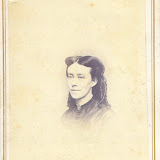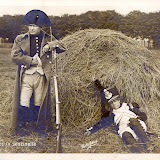Six subversive portraits of Turkish women
“A photographic portrait is a picture of someone who knows he’s being photographed, and what he does with this knowledge is as much a part of the photograph as what he’s wearing or how he looks.”
Richard Avedon
You’d think that a collection of close to 1000 studio portraits from Turkey in the 1920s and ‘30s would give you some knowledge of the society or at least a clearer idea than most people get but it can also confuse the picture. The six portraits here challenge some essential stereotypes about Turkish women, or they only look like they do. Missing from all of them is some basic information that would provide a context. Are they evidence that the society was rather more complex than we’ve been led to think, or are they the exceptions that prove the rule? These days, everyone agrees that the notion that a photographic portrait imparts a truth beneath its surface is wrong yet we can’t quite shake the idea that it should so therefore it might. We can guess why the woman above posed in a folk costume; it was either for her benefit or the photographer’s, but once the studio props were introduced the image became a fiction. In earlier times photographers like Pascal Sebah would hire models to dress as dervishes or street vendors but we weren’t supposed to know they were only actors. Here the pretence has been dropped but that only makes the intentions more obscure.
We have no idea who this woman is or what she went on to do in her life but in 1923, the year the Turkish republic was founded, universities across the country were made fully co-educational. L’Aigle was a prominent studio in Istanbul at the time and this woman would have been one of the first female graduates. She received her education in an era when, compared to most countries in Western Europe, laws regarding the status of women in Turkey were fundamentally more progressive and enlightened. Not that her degree or the voting powers she was given in 1935 would have necessarily helped. 90 years on and Turkey is ranked one of the worst countries in the world for women’s rights; proof, if you need it, that legislation achieves little without the support of popular will. Still, in one area the country is ahead in Europe. As a percentage - approximately 47% - the number of female academics employed at universities is higher than it is for France, Holland and Italy and only just behind Germany and the UK. So, what did she do with her education; go on to a professional career or end up back at home taking charge of the kids and the domestics?
Looking at film footage shot in Constantinople in the 1910s, it becomes apparent that as crowded as the streets and waterways are, very few women are evident. Research into women in the late Ottoman Empire invariably focuses on Muslims and their cloistered lives, but Christian and Jewish women didn’t have things any better. They also spent most of their lives indoors, dedicated to the home, with no say in civic society and if they did venture outside were expected to cover themselves. There wasn’t that much for a young bride to do, not when she had her new extended family of in-laws on hand to help with the cleaning, cooking and the endless cups of tea. No wonder that so much time was devoted to grooming. A lot has been written about the erotic significance of hair but for whom would a woman lavish so much attention to her tresses if not herself; especially when she was expected to keep it hidden in public? She is clearly not a Muslim but this is also a private portrait. No way would she have gone public with her hair down and her arms exposed. Note the wedding ring on her left middle finger. That appears to be more a Jewish than a Christian tradition although the subject of wedding rings and which finger they should be placed on is one cultural historians can’t seem to agree on.
The inscription on the back leaves no doubt this photograph was taken in the Ottoman Empire, and the Armenian Sisters of the Immaculate Conception were a prominent Catholic order in Constantinople at the turn of the century, but does that information help? From high art to lowbrow, in Christian art nuns are usually young, beautiful and faintly glamorous but in reality they were expected to be dowdy, almost sexually repellent. It isn’t entirely clear if she is wearing make-up, if so it is very lightly applied but she has devoted a little attention to her eyebrows. She may have been a model for a holy picture, in which case whoever commissioned the portrait ought to have been sued for false advertising.
One statement you can make about Turkish society after you have seen enough images is that the women are much more physical with each other than most Europeans. They wrap their arms around each other and nestle into one another’s breast in ways that would get an implicitly sexual interpretation if they were English or American. It is especially true when they are sisters. That’s merely a cultural difference though it can obviously elevate the intrigue a photo holds. Still, this portrait wouldn’t be so interesting and the connotations not so strong if the woman on the right wasn’t wearing a very manly uniform. In the 1920s Ataturk pushed for women to have the same place in the armed services as men but met resistance from military commanders, who used the international argument; women were too important for the future of children to have a place on the battlefield. Ataturk did manage to have his adopted daughter Sabiha Gokcen entered into the air force where she became the world’s first female fighter pilot, but the most women in general achieved were expanded roles in the military bureaucracy. That sounds like a very logical, sensible and placatory interpretation, but that doesn’t mean it is correct. First impressions don’t always require deeper analysis.
Just to reinforce notions of complexity and equivocality, here she is again, with another friend, and if you wanted to argue that her uniform in the first photo was sufficiently ambiguous to be possibly non military, here there is no doubt. Note that again neither of them wears insignia so they probably have office jobs. There are a few accounts of Turkish and British women taking up arms in the First World War but a common thread is that they arrived at the battlefront as nurses and fought out of necessity. There is also a long tradition of women warriors in Turkish history but they turn to defending the village or the town when the army is absent or in retreat and are not part of the official military. So why should this image be so striking? Possibly because we are so unused to seeing women from that era in military uniform that we assume there is a deeper story attached to it, and then because they are from a society we assume was more conservative than the West’s. Yes, there’s that but more to the point, this is probably not an official portrait. The women went to the studio, chose the backdrop, the setting and the props and then posed, as themselves, self possessed and fully aware of the image’s incongruity. This is a photograph that could only be taken in the midst of revolution, when they both know their traditional roles are being overturned.
VIEW THE GALLERY HERE |
| POSTCARDS FROM THE EDGE II |































